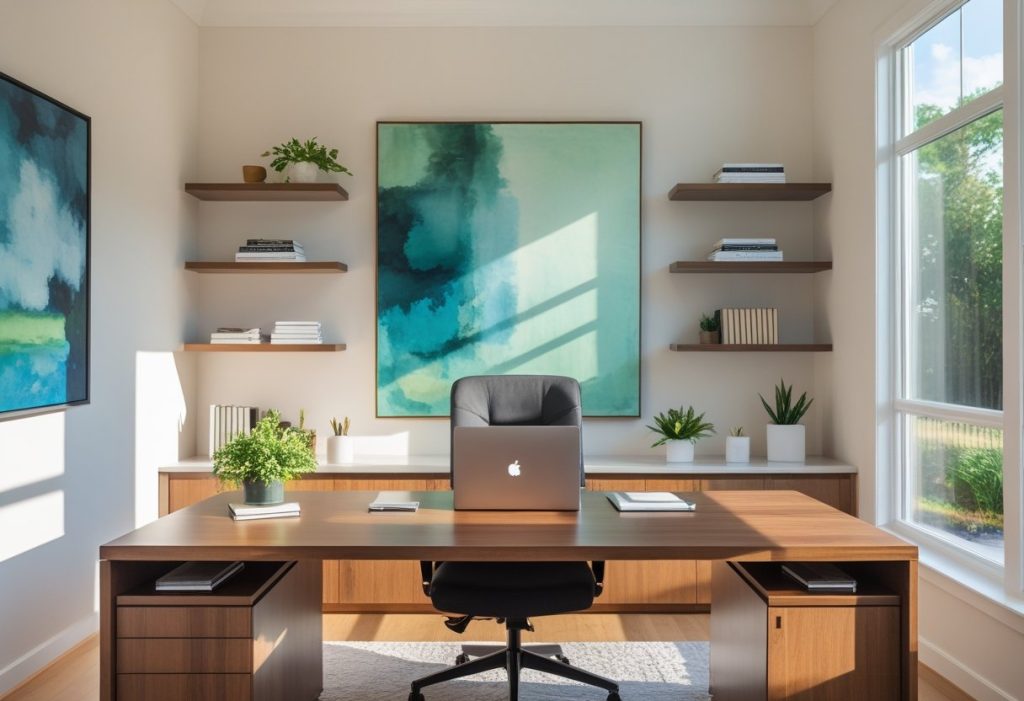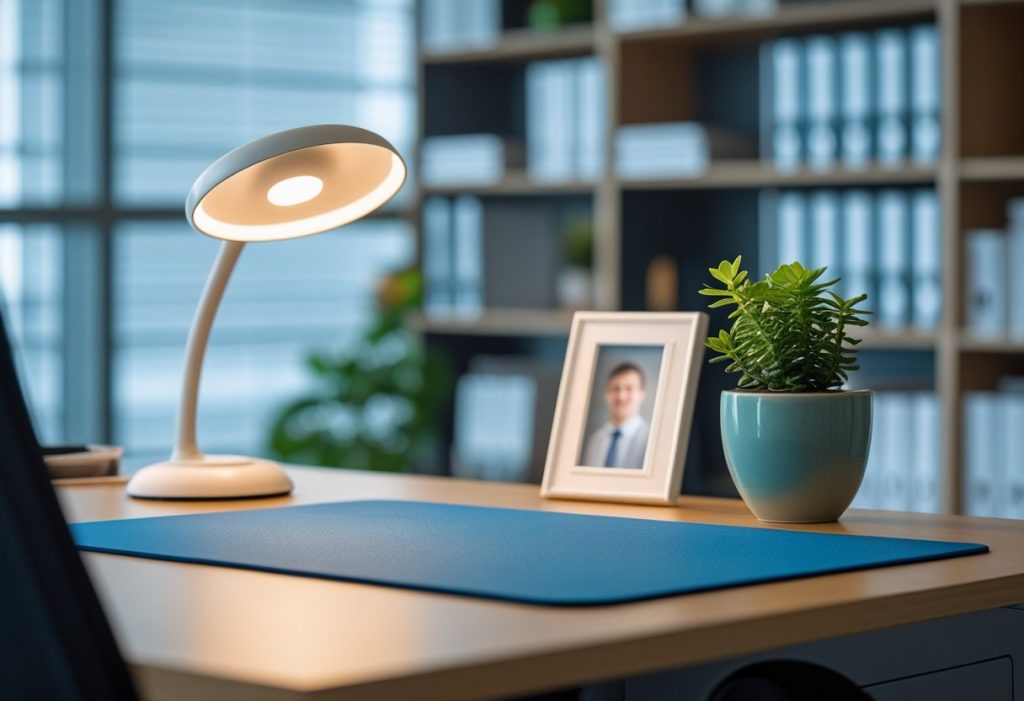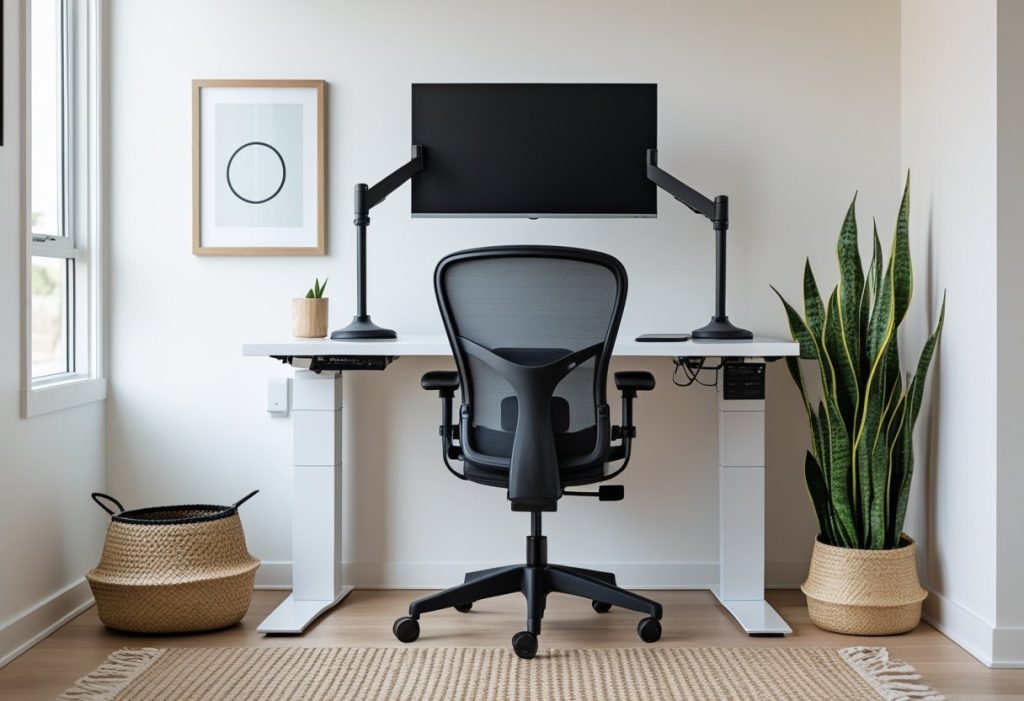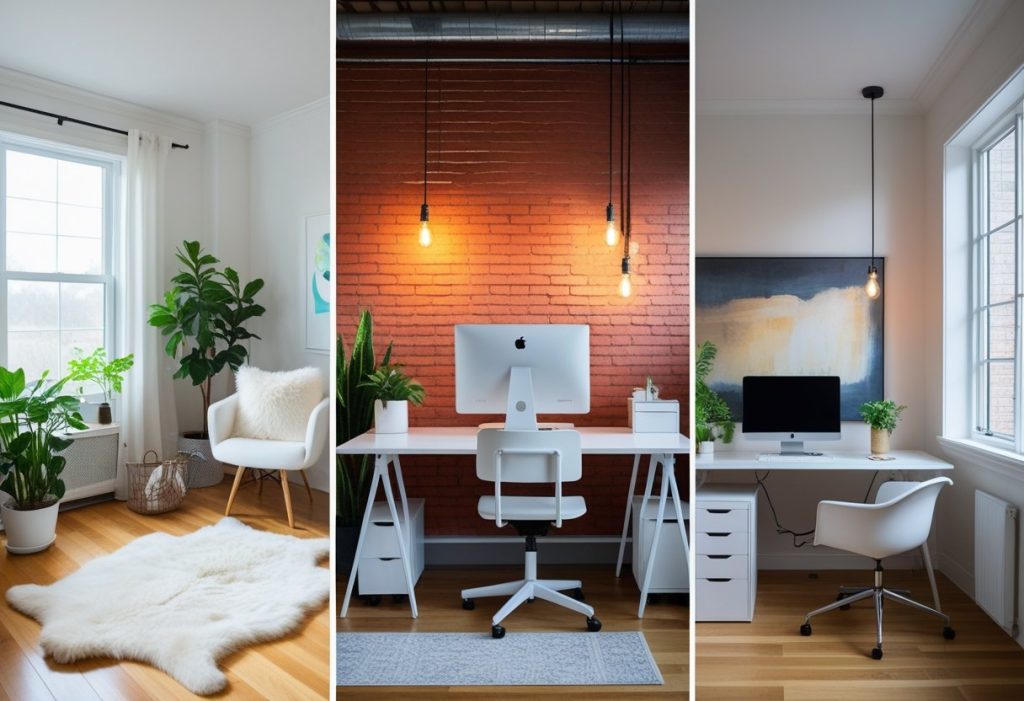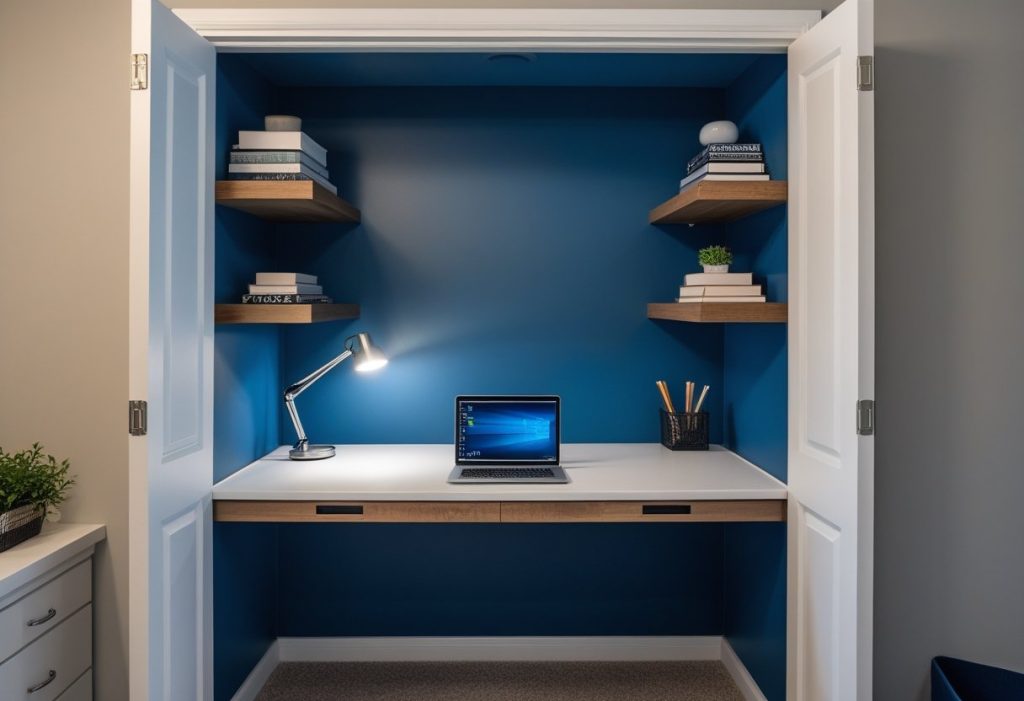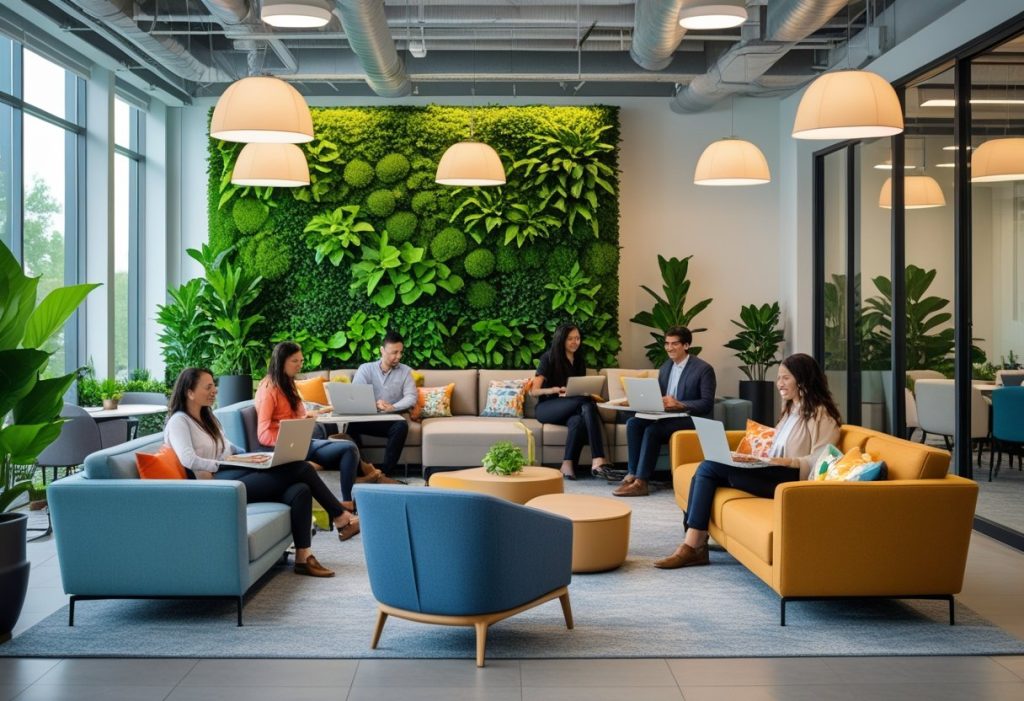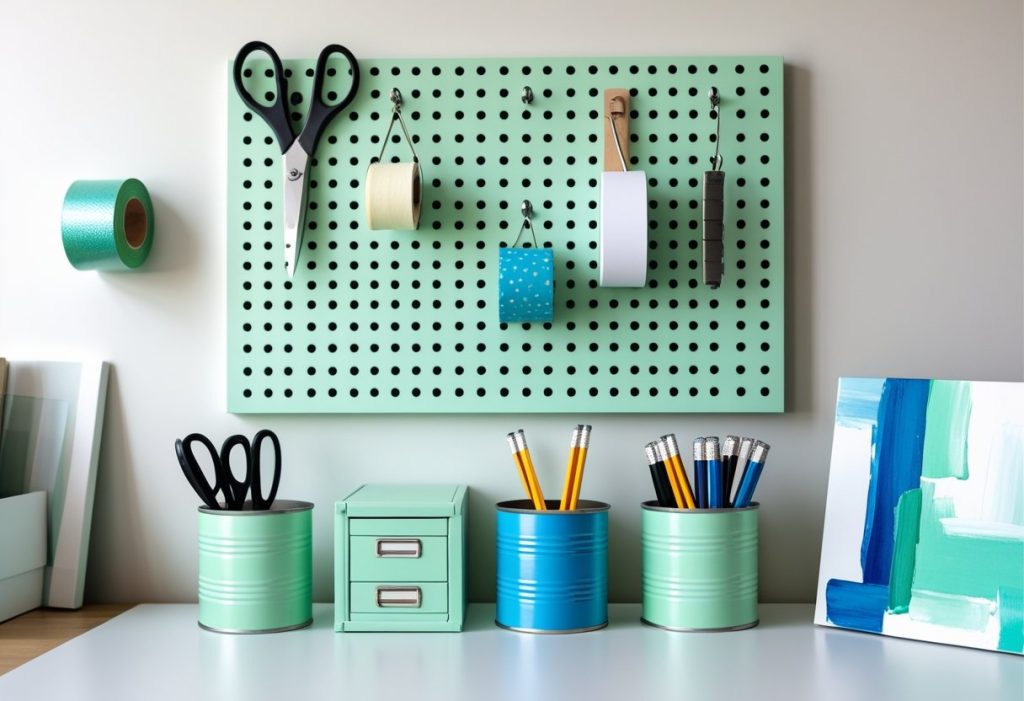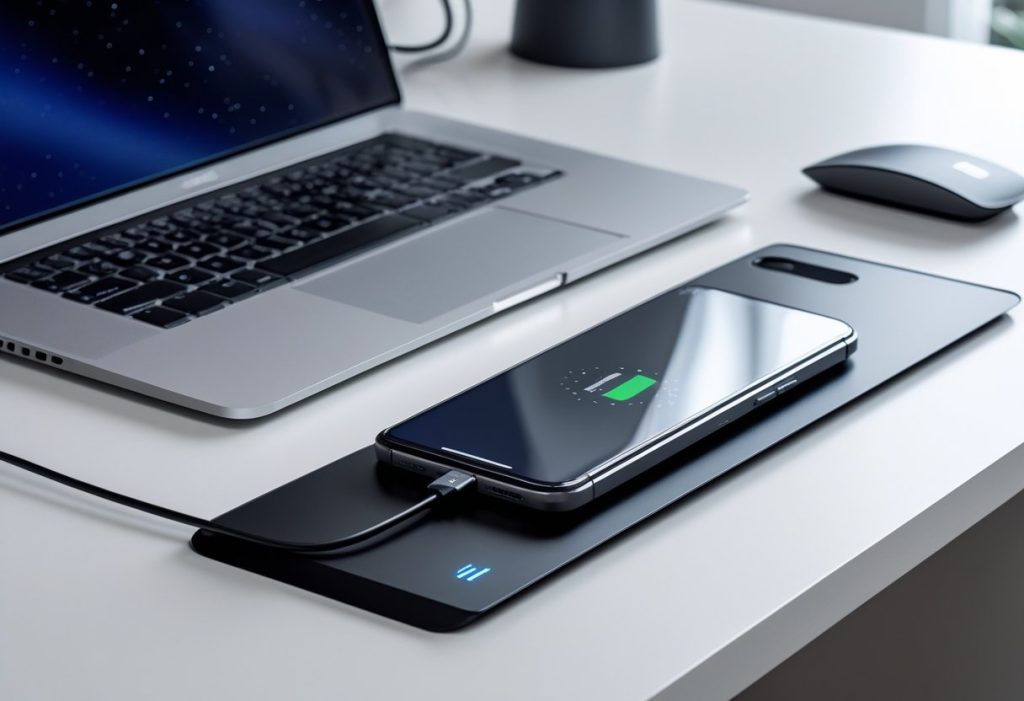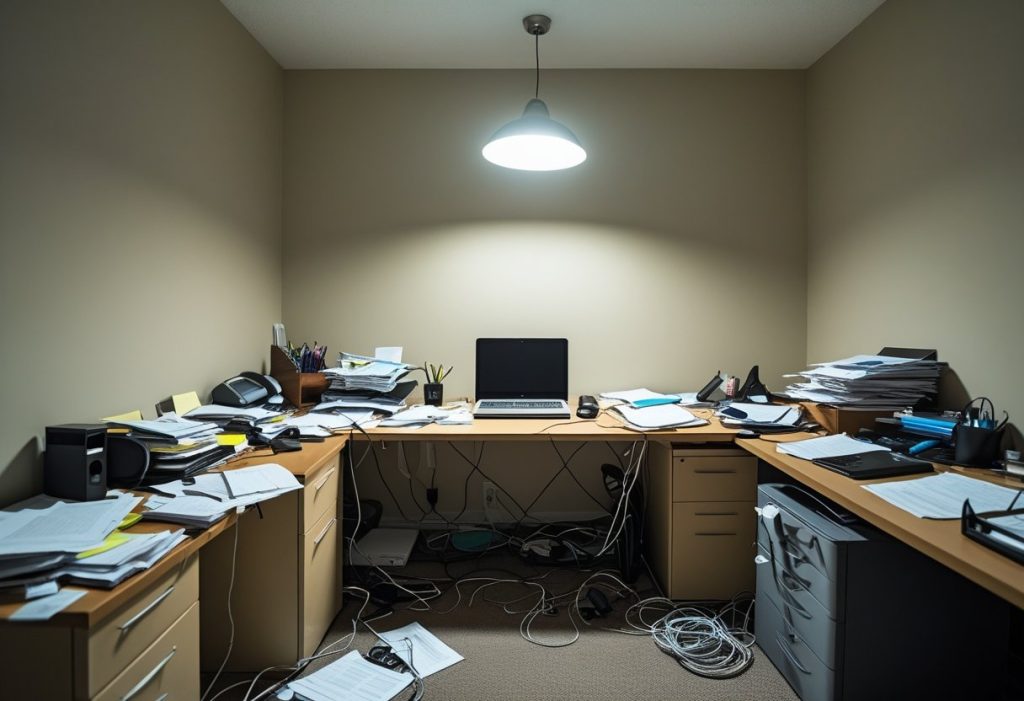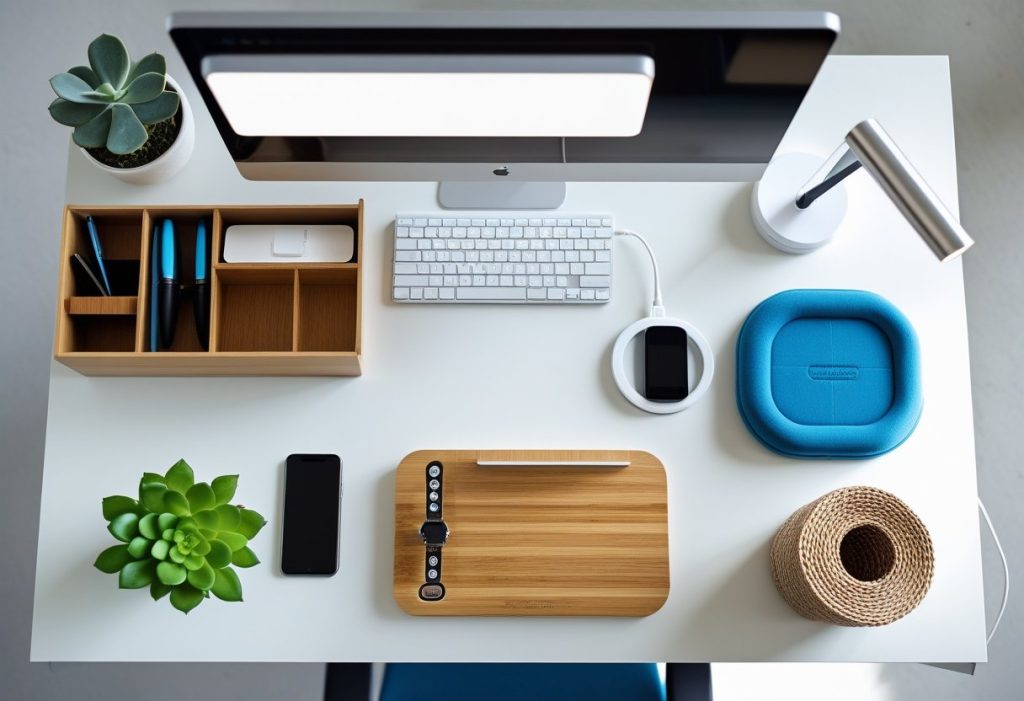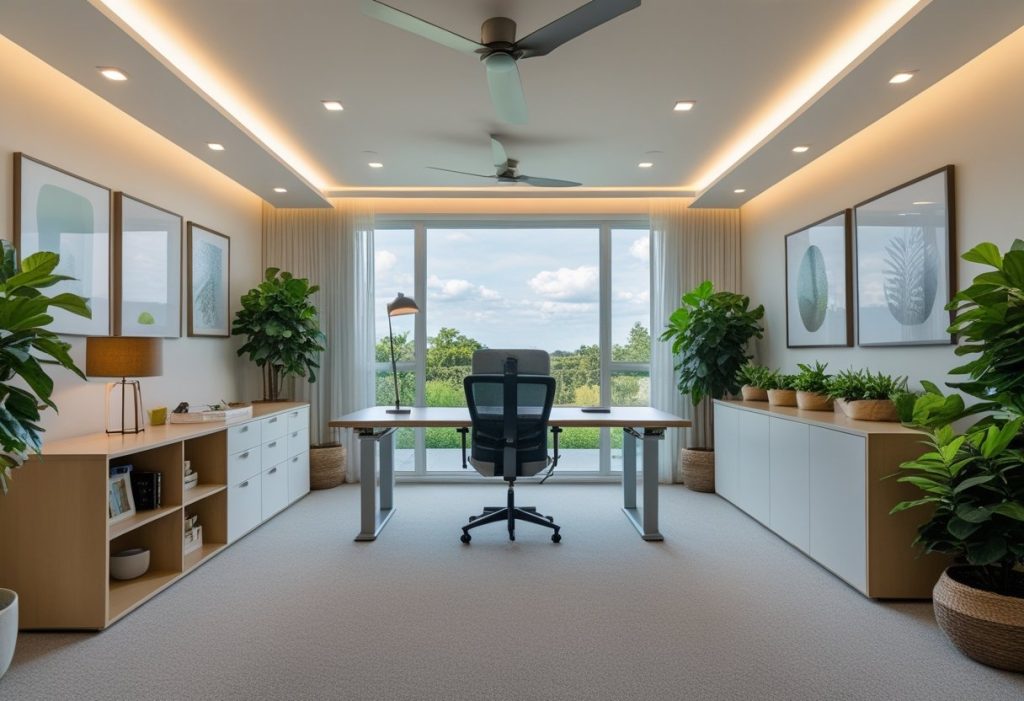1. Introduction: Why Office Decor Matters
In the evolving landscape of work, our surroundings have never been more critical. Whether you’re navigating the corporate world from a high-rise or managing a business from a spare room, your environment is a silent partner in your daily grind. This is where the power of intentional office decor comes into play.
It’s a common misconception that office decor is merely about aesthetics. While a beautiful space is certainly a goal, the true value runs much deeper. The objects you choose, the colors you surround yourself with, and the light you work by are not passive. They actively influence your mood, focus, and output.
Think about the last time you walked into a sterile, dimly lit, and cluttered office. Your energy likely plummeted. Conversely, a space filled with light, personal touches, and organized systems invites you to sit down and create. This isn’t just a feeling; it’s a psychological response.
Your workspace should be a catalyst for productivity, not a barrier to it. Effective office decor bridges the gap between a place you have to be and a space you want to be in. It’s about crafting an environment that supports your professional ambitions while nurturing your well-being.
For remote workers, this is doubly important. The home office must clearly delineate “work mode” from “home mode.” The right office decor creates this mental and physical boundary, enhancing focus during work hours. It also allows you to fully disconnect when the day is done.
Ultimately, investing in your office decor is an investment in yourself, your brand, and your future success. It signals that you value your work and respect the process of creating it. This guide will walk you through every step of designing a workspace that is not only modern and inspiring but also profoundly productive.
Let’s transform your office from a mere functional area into your most powerful professional tool.
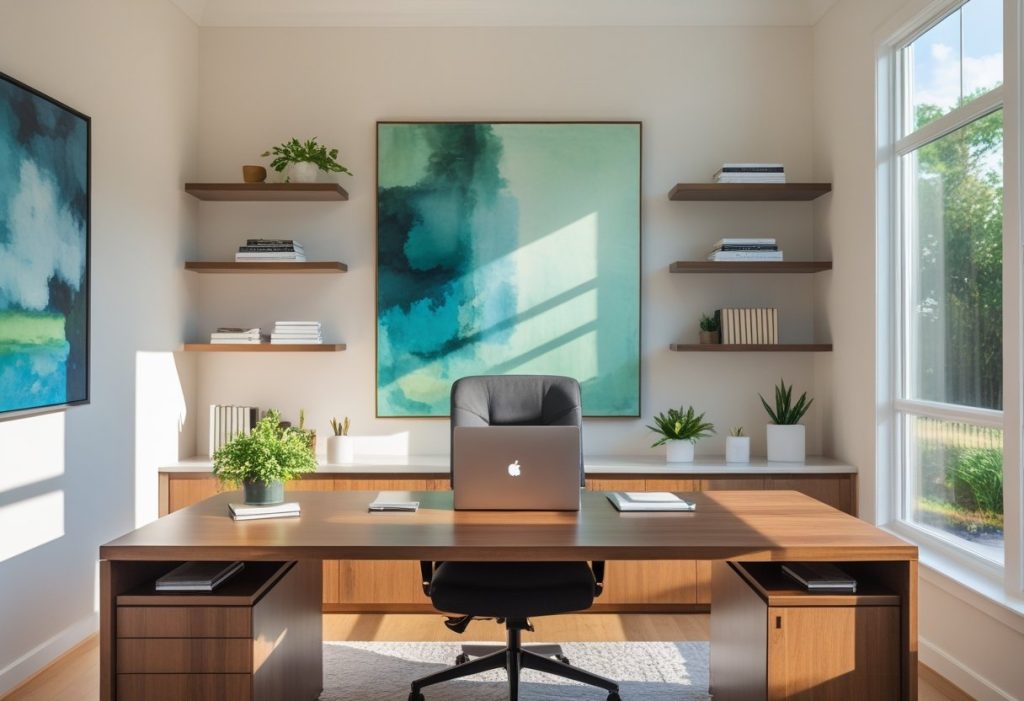
2. Psychology of Office Decor (800 words)
The connection between our environment and our mental state is undeniable. Environmental psychology provides a scientific backbone for why certain design choices in our office decor have such a profound impact. It’s about designing with intention, using space to trigger desired cognitive and emotional responses.
Color: The Mood Setter
Color is one of the most powerful tools in your office decor arsenal. Different hues stimulate different parts of the brain, influencing everything from concentration to creativity.
- Blue: Known to enhance productivity and calmness. It’s ideal for tasks requiring deep focus and mental clarity.
- Green: Promotes balance and harmony. It’s easy on the eyes and reduces anxiety, perfect for long work hours.
- Yellow: Sparks creativity, optimism, and energy. Use it as an accent color to stimulate innovation.
- Red: Increases heart rate and is associated with urgency. Best used sparingly for accents to draw attention.
- Neutral (White, Grey, Beige): Create a sense of space, cleanliness, and minimalism. They provide a calm backdrop that lets other elements shine.
Lighting: Beyond Illumination
Lighting dictates the entire atmosphere of a room. Harsh, fluorescent overhead lighting can cause eye strain and fatigue. Natural light, however, is the gold standard for office decor. It regulates circadian rhythms, boosts vitamin D, and improves mood.
When natural light is limited, a layered lighting approach is key. Combine ambient (overhead), task (desk lamps), and accent (floor lamps, LED strips) lighting. This allows you to adjust the light for different tasks and times of day, reducing glare and creating a more comfortable environment.
Nature: The Biophilic Effect
Biophilia is humankind’s innate tendency to connect with nature. Incorporating natural elements into your office decor—a concept known as biophilic design—lowers stress, enhances creativity, and improves well-being.
This goes beyond just adding a plant. Think wood finishes, stone accents, natural textiles like jute or wool, and a view of the outdoors. Even images of nature can have a positive effect. The presence of plants also improves air quality, making your space healthier.
Layout & Space: The Flow of Work
How you arrange your furniture directly impacts your workflow and mindset. A cluttered, cramped space leads to a cluttered mind. It can increase cortisol levels, the body’s primary stress hormone.
An open, organized layout promotes a sense of control and efficiency. The principle of “a place for everything” reduces cognitive load. You spend less mental energy searching for items and more on your actual work. Your office decor layout should facilitate movement and minimize distractions.
Personalization: The Identity Anchor
A sterile, impersonal space can feel isolating. Personalizing your office decor with photos, artwork, or mementos fosters a sense of identity and emotional comfort. These items act as visual reminders of your life, goals, and achievements outside of work.
This personal connection to your space increases emotional investment and job satisfaction. It makes the office feel like your domain, a place where you belong and can do your best work. The key is balance—enough personality to inspire, not so much that it becomes distracting.
Understanding these psychological principles allows you to move beyond random decoration. You can now curate a space that actively works in your favor, every single day.
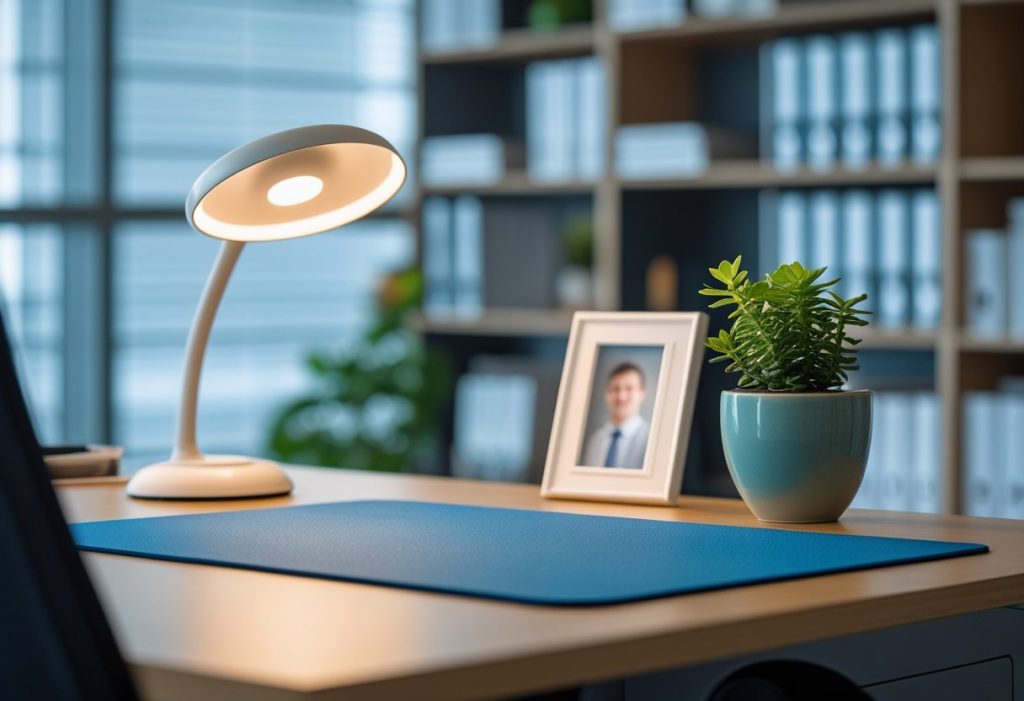
3. Essential Elements of Office Decor
Building a functional and beautiful workspace requires a focus on foundational elements. These are the non-negotiable components of effective office decor that form the bedrock of your daily productivity and comfort. Neglecting them can undermine even the most stylish additions.
The Ergonomic Foundation
Your health and comfort are paramount. Office decor should be beautiful, but never at the expense of ergonomics. This is the science of designing the workplace to fit the user, preventing strain and injury.
- The Chair: Invest in a high-quality, adjustable ergonomic chair. Look for lumbar support, adjustable height and armrests, and breathable material. You spend hours in it; it’s worth the investment.
- The Desk: Height is crucial. Your desk should allow your elbows to rest at a 90-degree angle when typing. Consider a sit-stand desk for the ultimate in flexibility and health benefits.
- Monitor Placement: The top of your screen should be at or slightly below eye level. This prevents neck strain. Use a monitor arm for perfect positioning.
- Keyboard and Mouse: Ergonomic models can help keep your wrists in a neutral position, combating carpal tunnel syndrome.
Intelligent Storage Solutions
Clutter is the enemy of focus. Intelligent, stylish storage is a critical element of office decor that maintains visual calm and operational efficiency.
- Vertical Space: Use floating shelves, bookcases, and wall-mounted organizers. This clears the desk surface and draws the eye upward, making the room feel larger.
- Desk Organizers: Trays, pen holders, and cable management boxes are small items with a huge impact. They create a sense of order right where you work.
- Filing and Cabinets: Choose pieces that complement your style—a sleek filing cabinet, a vintage credenza, or modern woven baskets can all hide necessary clutter beautifully.
Seating for Collaboration and Comfort
If your space allows for guests or clients, additional seating is a must. This element of office decor defines the tone of your interactions.
- Guest Chairs: Choose comfortable yet supportive chairs that match your aesthetic. A small conversation area can make meetings more relaxed and collaborative.
- Accent Chairs or a Sofa: In a larger office, a small sofa or a comfortable armchair creates a zone for reading, brainstorming, or taking a mental break.
Textiles for Warmth and Acoustics
Hard surfaces create echo and a cold, impersonal feel. Textiles are the secret weapon of cozy office decor. They absorb sound and add layers of texture and warmth.
- Rugs: An area rug defines the workspace, adds color and pattern, and reduces noise from footsteps and chair movement.
- Curtains or Blinds: Beyond controlling light, fabric curtains soften a room and help with acoustics. Choose light-filtering options for a soft glow.
- Throws and Pillows: A throw blanket over an accent chair or a few decorative pillows adds a touch of comfort and homeliness, making the space more inviting.
Wall Decor with Purpose
Blank walls are a missed opportunity. Wall decor is where you can express personality and reinforce your brand, but it should also serve a purpose.
- Whiteboards or Corkboards: Essential for brainstorming, to-do lists, and displaying important reminders. Choose frames that match your decor.
- Artwork and Prints: Select pieces that inspire you or bring you joy. The subject matter and colors should contribute to the desired mood of your space.
- Mirrors: In a small office, a mirror can dramatically amplify light and make the space feel larger and more open.
Greenery: The Life Force
As discussed, plants are non-negotiable for psychological and air-quality benefits. They are the easiest way to inject life and color into your office decor.
- Low-Light Plants: Snake plants, ZZ plants, and pothos are virtually indestructible and thrive in office environments.
- Desktop Varieties: Small succulents, air plants, or a peace lily add a fresh touch without taking up much space.
- Statement Plants: A large fiddle leaf fig or monstera in a corner can become a stunning focal point and air purifier.
By mastering these essential elements, you create a workspace that is not just decorated, but fundamentally designed for success, health, and sustained productivity.
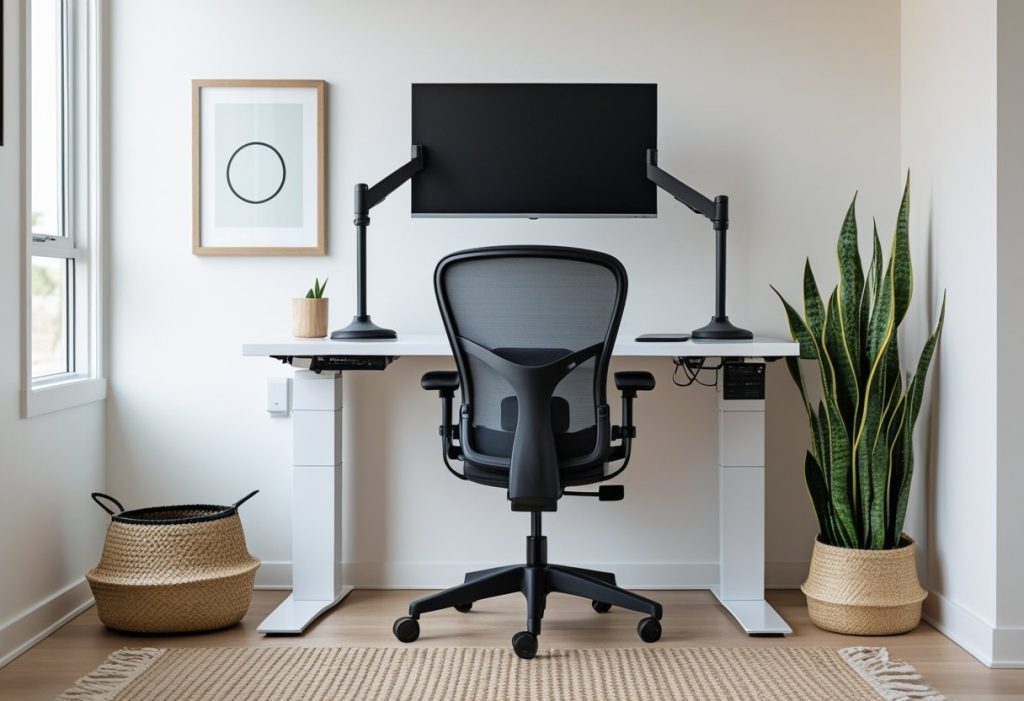
4. Types of Office Decor Styles
Your office decor should be a reflection of your personal taste or your company’s brand identity. Choosing a defined style creates a cohesive, intentional look that feels curated rather than thrown together. Here are some of the most popular and effective office decor styles to consider.
Modern Minimalist
This style champions the principle of “less is more.” It’s characterized by clean lines, a neutral color palette, and a lack of clutter. The focus is on functionality and simplicity.
- Key Features: Sleek furniture (often with metal or glass accents), monochromatic or neutral color schemes (black, white, grey, beige), and unadorned spaces.
- Furniture: Low-profile desks, simple ergonomic chairs, and hidden storage solutions. Every item has a purpose.
- Decor: Abstract art, a single statement plant, and strategic lighting. The beauty is in the negative space and the quality of each piece.
- Best For: Those who are easily distracted by clutter and want a calm, focused, and sophisticated environment.
Industrial
Inspired by converted warehouses and lofts, the industrial style is raw, utilitarian, and edgy. It embraces a “unfinished” look that feels both rugged and stylish.
- Key Features: Exposed brick walls, ductwork, and pipes. Raw materials like reclaimed wood, concrete, and metal dominate.
- Furniture: Desks with metal frames and wooden tops, vintage factory carts used as tables, and leather armchairs.
- Decor: Edison bulb lighting, metal shelving units, and vintage industrial signs. The palette is often neutral with dark accents.
- Best For: Creative professionals, startups, and those who want a space that feels energetic, authentic, and a bit rebellious.
Scandinavian (Scandi)
Scandi design prioritizes comfort, functionality, and connection to nature. It’s known for creating warm, inviting, and light-filled spaces that promote well-being (hygge).
- Key Features: Light colors (especially whites and light woods), natural light, and minimalist forms. Functionality is key.
- Furniture: Light wood desks (like oak or birch), simple designs, and ergonomic principles. Everything is designed to be useful and beautiful.
- Decor: Plenty of textiles like sheepskin rugs and wool throws, potted plants, and simple, functional accessories. The vibe is cozy and serene.
- Best For: Home office workers and anyone who wants a peaceful, warm, and naturally inspiring workspace.
Bohemian (Boho)
The boho style is eclectic, colorful, and rich with personality. It’s less about rules and more about curating a space that feels layered, creative, and globally inspired.
- Key Features: A mix of patterns, textures, and colors. Natural elements and vintage finds are central to the look.
- Furniture: A mix of pieces—a vintage wooden desk, a colorful patterned chair, floor cushions for additional seating.
- Decor: Macrame wall hangings, plenty of plants (hanging and potted), patterned rugs, tapestries, and collections of art and objects.
- Best For: Free-spirited creatives, writers, and artists who draw energy from a vibrant, personalized, and inspiring environment.
Traditional
Elegant, polished, and timeless, the traditional style draws inspiration from classic European design. It conveys stability, professionalism, and sophistication.
- Key Features: Rich, dark wood tones (like mahogany or cherry), ornate details, and a symmetrical layout.
- Furniture: A substantial wooden desk, a high-backed leather executive chair, and built-in bookcases.
- Decor: Classic artwork in gilt frames, a sophisticated desk set, luxurious fabrics like leather and velvet, and a traditional rug.
- Best For: Law firms, executive suites, and home offices where projecting an image of established authority and trust is important.
Mid-Century Modern
This style, originating from the 1950s and 60s, remains incredibly popular. It features organic shapes, minimalist forms, and a seamless integration with nature.
- Key Features: Clean lines, gentle organic curves, and a mix of traditional and non-traditional materials.
- Furniture: Desks with tapered legs, an Eames-style office chair, and low-profile credenzas.
- Decor: Atomic age accessories, geometric patterns, abstract art, and wood accents. The color palette often includes muted tones with pops of mustard yellow, olive green, or orange.
- Best For: Those who appreciate retro design, functionality, and a space that feels both nostalgic and timelessly cool.
Transitional
This style offers the best of both worlds by blending traditional and contemporary elements. It strikes a perfect balance, feeling both classic and current, formal and comfortable.
- Key Features: Neutral foundations with a mix of old and new. It avoids extremes, favoring curated simplicity.
- Furniture: A modern desk with traditional legs, a classic chair in a updated fabric, or a sleek lamp on a vintage table.
- Decor: A neutral color scheme with layered textures (linen, wood, metal) and artwork that isn’t tied to a specific era.
- Best For: Almost anyone. It’s a safe, sophisticated, and highly adaptable style that appeals to a wide range of tastes.
Choosing your style is the first step in creating a cohesive office decor plan. Don’t be afraid to mix elements, but always keep your core style in mind to maintain harmony.
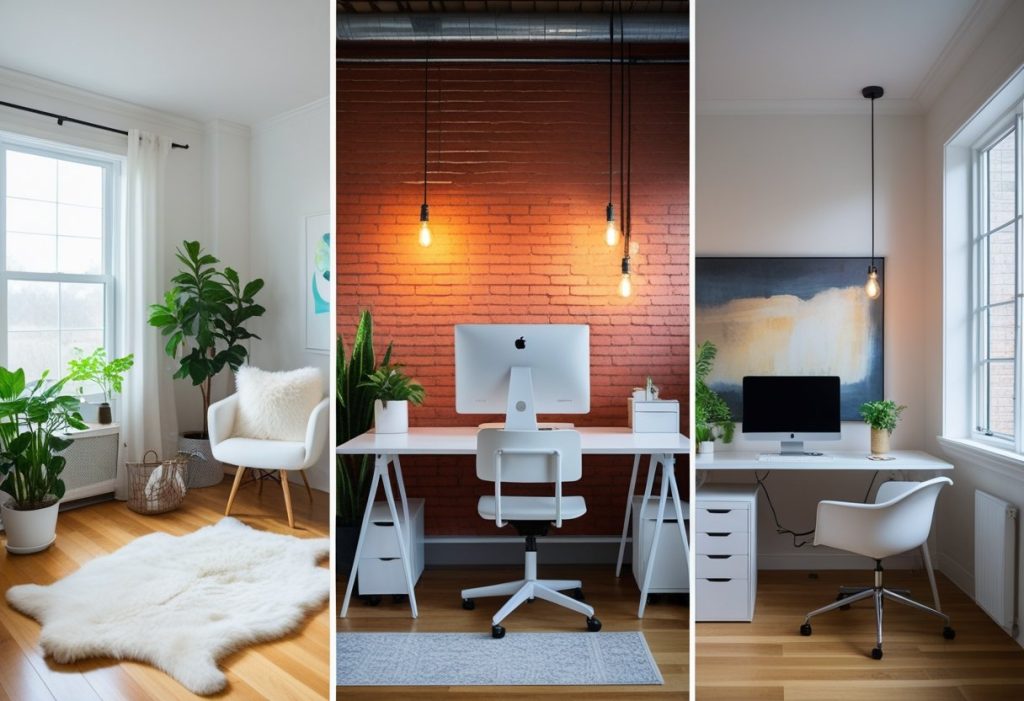
5. Home Office Decor Ideas (1200 words)
The home office presents a unique opportunity: total creative control. Without corporate guidelines, you can design a space that is perfectly tailored to your work style and personal taste. Here are actionable office decor ideas to maximize your productivity and joy in a home setting.
Define Your Zone
The first rule of home office decor is separation. If you don’t have a dedicated room, you must create a visual and mental boundary.
- Room Divider: A stylish bookshelf, a folding screen, or even a large curtain can cordon off your workspace from the rest of the room.
- Rug Definition: Use a large area rug to physically define your office area within a larger room. This psychologically marks the territory.
- Facing Away: Position your desk so you’re not facing your bed or a busy living area. Face a window or a wall you can decorate instead.
Maximize Small Spaces
Not everyone has a spare room. Clever office decor can turn a nook, closet, or corner into a highly functional workspace.
- The Cloffice: Transform a closet by removing the doors and installing a desk at the right height. Add shelving above and a pegboard on the back wall for storage. When you’re done working, you can simply close a curtain.
- Wall-Mounted Desks: A floating desk saves crucial floor space. Pair it with wall-mounted shelves for a completely vertical workstation.
- Multipurpose Furniture: Choose a desk that can double as a console table or a bookshelf that holds both work supplies and home decor.
Let There Be (The Right) Light
Lighting is perhaps the most important element in a home office. Prioritize your position.
- Desk by the Window: This is the ideal scenario for ample natural light. Position your desk perpendicular to the window to avoid glare on your screen.
- The Layered Approach: Combine a ceiling light (ambient), a focused task lamp on your desk, and an accent lamp on a shelf or floor. Use warm-white bulbs to avoid a cold, clinical feel.
- Mirror Magic: Place a mirror opposite or adjacent to a window to bounce natural light around the room, making it feel brighter and larger.
Personalize Your Inspiration
This is your chance to make the space truly yours. Personalization is what separates a home office from a corporate cubicle.
- Inspiration Board: Create a large corkboard or magnetic board to pin inspiring quotes, project mood boards, photos, and important notes.
- Display Collections: Do you collect vintage cameras, pottery, or books? Use open shelving to display them. They become part of your office decor and spark joy.
- Art That Speaks to You: Don’t choose generic art. Select pieces from local artists, prints from your favorite travels, or even your own creations.
Create a Comfort Corner
If space allows, create a small area separate from your desk for different modes of thinking.
- Reading Nook: A comfortable armchair, a small side table, and a good lamp create a perfect spot for reading reports or brainstorming.
- Whiteboard Wall: Dedicate an entire wall to paint with whiteboard or chalkboard paint. It’s perfect for massive brainstorming sessions and can be easily erased.
Smart Tech Integration
Technology is essential, but wires are unsightly. Managing them is a critical part of modern home office decor.
- Cable Management: Use adhesive cable clips, zip ties, or a cable management sleeve to gather wires neatly along desk legs.
- Wireless Where Possible: Opt for a wireless keyboard, mouse, and charger to minimize cord clutter on your desk surface.
- Tech Box: Use a stylish box or basket with holes to hide power strips and the tangled mess of plugs.
Embrace Color Confidently
While neutrals are safe, don’t be afraid of color in your home office. It’s a powerful tool to define your space and mood.
- Accent Wall: Paint the wall behind your desk a bold color like navy blue, emerald green, or terracotta. It creates a dramatic backdrop for video calls and adds depth.
- Colorful Furniture: A brightly colored bookshelf, a vibrant area rug, or a unique chair can serve as a stunning focal point.
- Accessorize with Color: If you’re hesitant, start small with colorful desk accessories, artwork, and textiles. You can always change them out.
Your home office should be your sanctuary for focus and creativity. By implementing these office decor ideas, you can build a space that you love to work in, which in turn, will help you do your best work.
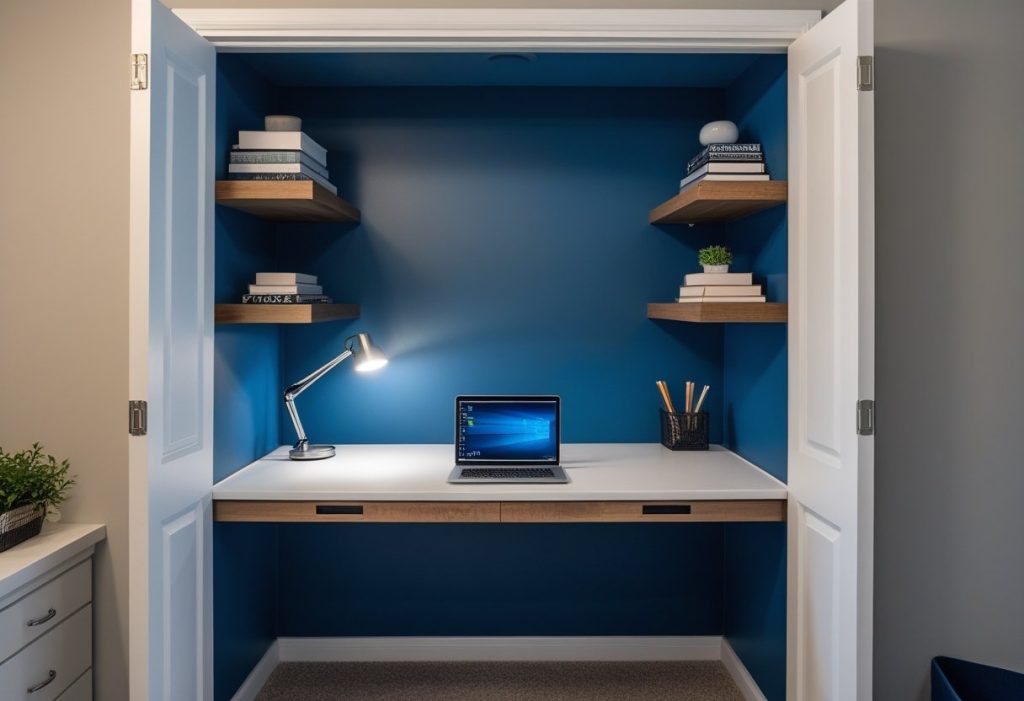
6. Corporate Office Decor Trends
The corporate world is undergoing a massive shift in how it views the workplace. The office is no longer just a place to process tasks; it’s a strategic tool for attracting talent, fostering culture, and encouraging innovation. Modern corporate office decor trends reflect this new philosophy, moving away from sterile cubicle farms toward dynamic, human-centric environments.
Biophilic Design: Bringing the Outdoors In
This is arguably the biggest trend in corporate design. Companies are deeply integrating nature into their office decor to improve employee well-being, reduce stress, and enhance creativity.
- Living Walls: Vertical gardens filled with plants act as stunning natural art pieces and improve air quality.
- Abundant Greenery: Beyond a single potted plant, offices are incorporating large trees, numerous plants in common areas, and even interior courtyards.
- Natural Materials: Using wood, stone, bamboo, and natural textiles throughout the space reinforces the connection to the natural world.
- Maximized Natural Light: Open floor plans and glass walls allow daylight to penetrate deep into the building, reducing reliance on artificial lighting.
Agile and Activity-Based Working (ABW)
The one-size-fits-all desk is disappearing. ABW provides employees with a variety of settings designed for specific tasks, giving them choice and control over where and how they work.
- Neighborhoods: Zones are created for different activities: quiet focus pods, collaborative hubs, phone booths for private calls, and social cafes for informal meetings.
- Hot-Desking & Free-Address: Instead of assigned seats, employees choose a workspace each day that suits their needs, supported by lockers and mobile technology.
- Flexible Furniture: Lightweight, movable furniture on casters allows teams to easily reconfigure spaces for projects of different sizes and needs.
Hospitality-Inspired Design
Offices are starting to feel more like high-end hotels or cozy lounges. This trend makes the office a destination employees want to go to, fostering a sense of community and comfort.
- Resimercial Design: A blend of residential and commercial furniture. Plush sofas, armchairs, coffee tables, and warm lighting replace rigid, impersonal furniture.
- Amenity-Rich Spaces: Offices now feature coffee bars, fully-stocked kitchens, game rooms, nap pods, and fitness centers. These perks encourage employees to stay on-site and connect with colleagues.
- Warm Color Palettes: Moving away from stark white and beige, corporate palettes now incorporate warmer, earthier tones that feel more inviting and less clinical.
Focus on Wellness and Amenities
Employee wellness is a core business strategy. Office decor and design are being used to directly support physical and mental health.
- Ergonomics for Everyone: Providing high-quality, adjustable chairs and sit-stand desks is now standard. Companies are investing in employee health to boost productivity and reduce absenteeism.
- Wellness Rooms: Dedicated, quiet rooms for meditation, prayer, nursing, or just a mental break are becoming essential.
- Acoustic Control: With open plans comes noise. Companies are investing in sound-absorbing panels, baffles, carpets, and furniture to create auditory privacy and reduce distracting background noise.
Hybrid Work Hubs
As hybrid work becomes the norm, the purpose of the corporate office is changing. It’s becoming a hub for collaboration, culture, and connection that can’t be replicated at home.
- Technology-Enabled Rooms: Meeting rooms are equipped with high-quality video conferencing systems to seamlessly include remote team members.
- Collaboration-Centric Layouts: More space is allocated to team areas, project rooms, and casual meeting spots than to individual desks.
- Brand Expression: Companies are using their office decor to powerfully express their brand identity, mission, and values through color, art, and messaging, strengthening culture.
Sustainability and Ethical Design
Businesses are increasingly mindful of their environmental footprint. Sustainable office decor is both an ethical choice and a point of pride for employees and clients.
- Recycled and Upcycled Materials: Furniture made from recycled materials, reclaimed wood, and repurposed items is highly sought after.
- Low-VOC Products: Using paints, adhesives, and materials with low volatile organic compounds (VOCs) ensures better indoor air quality.
- Durability and Longevity: Investing in well-made, timeless pieces rather than cheap, disposable furniture is a more sustainable approach.
These trends show a clear movement towards creating corporate spaces that prioritize the human experience, proving that thoughtful office decor is a smart investment in a company’s most valuable asset: its people.
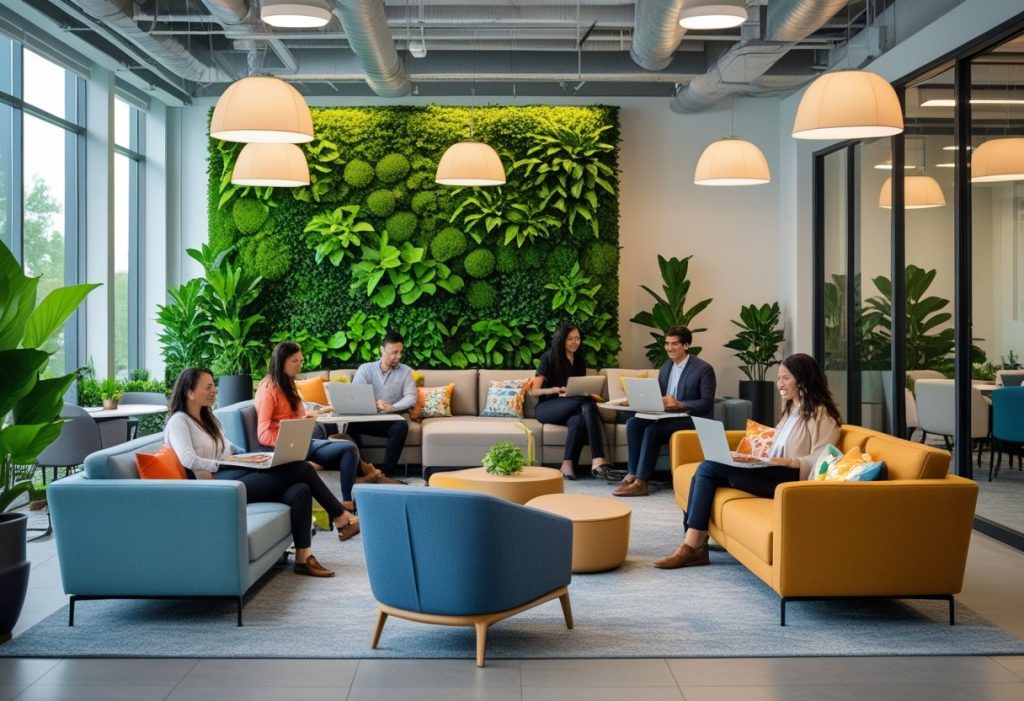
7. DIY Office Decor Ideas
A beautiful and functional office doesn’t have to break the bank. DIY office decor projects allow you to infuse your space with unique personality, create custom solutions, and enjoy the satisfaction of building something with your own hands. Here are some creative and achievable ideas.
The Custom Desk Organizer
Tame desk clutter with a organizer you design yourself.
- Painted Cans/Jars: Clean and remove labels from food cans or mason jars. Spray paint them in a cohesive color scheme that matches your office decor. They become perfect holders for pens, pencils, and brushes.
- Wooden Crate Desk Tray: Find a small wooden crate at a craft store. Sand it, paint or stain it, and add felt pads to the bottom. It’s ideal for corralling notebooks, mail, or larger items.
Statement Wall Art
Avoid expensive generic prints and create art that has meaning to you.
- Framed Fabric or Wallpaper: Find a fabric or a remnant of wallpaper with a pattern you love. Stretch it over a canvas or frame it for a large, impactful piece of art for a fraction of the cost.
- DIY Abstract Canvas: You don’t need to be an artist. Choose 2-3 colors that complement your office decor. Use painter’s tape to create geometric shapes or simply experiment with blending colors on a large canvas. It’s modern and personal.
The Functional Pegboard
A pegboard is the ultimate DIY office decor solution for vertical storage and organization. It’s highly customizable and incredibly functional.
- Paint It: Don’t settle for boring beige. Paint the pegboard a bold color that becomes a focal point, or match it to your wall color so it blends in.
- Accessorize: Use a combination of hooks, shelves, and small containers to hold everything from office supplies and headphones to small plants and craft tools.
Upcycled Furniture
Give old furniture a new life and a new purpose in your office.
- Desk Makeover: Find a old, solid wood desk at a thrift store or garage sale. Sand it down and paint or re-stain it. Replace the hardware for an instant style upgrade.
- Ladder Shelf: An old wooden ladder can be cleaned up and leaned against a wall to become a unique, rustic bookshelf. Simply add wooden planks across the rungs.
Personalized Accessories
Small, custom touches make a big difference in personalizing your office decor.
- Custom Mousepad: Use a website to create a custom mousepad with a favorite photo, inspirational quote, or pattern that fits your theme.
- Decorative Boxes: Cover simple cardboard or wooden storage boxes with decorative contact paper, wrapping paper, or fabric to create pretty hiding places for clutter.
Cable Management Solutions
Wires are the enemy of a clean aesthetic. DIY solutions can be both effective and attractive.
- Binder Clip Trick: Clip large binder clips to the back edge of your desk and thread your cables through the metal arms. It’s a simple, nearly free solution.
- Decorative Cable Box: Find a nice-looking box (like a woven basket or a wooden crate). Cut a hole in the back for cords, and place your power strip and all its tangled cords inside.
A Cozy Textile Refresh
You can easily sew (or no-sew!) new textiles to update your space.
- DIY Desk Runner: Cut a piece of felt, faux leather, or pretty fabric to the size of your desk. It protects the surface and adds a pop of color and texture.
- No-Sew Pillow Covers: Use fabric glue or iron-on hem tape to create simple envelope-style covers for throw pillows on your guest chair.
Engaging in DIY office decor projects allows you to create a space that is uniquely yours, all while being kind to your budget. The personal connection you have to hand-made items will make your office feel even more special.
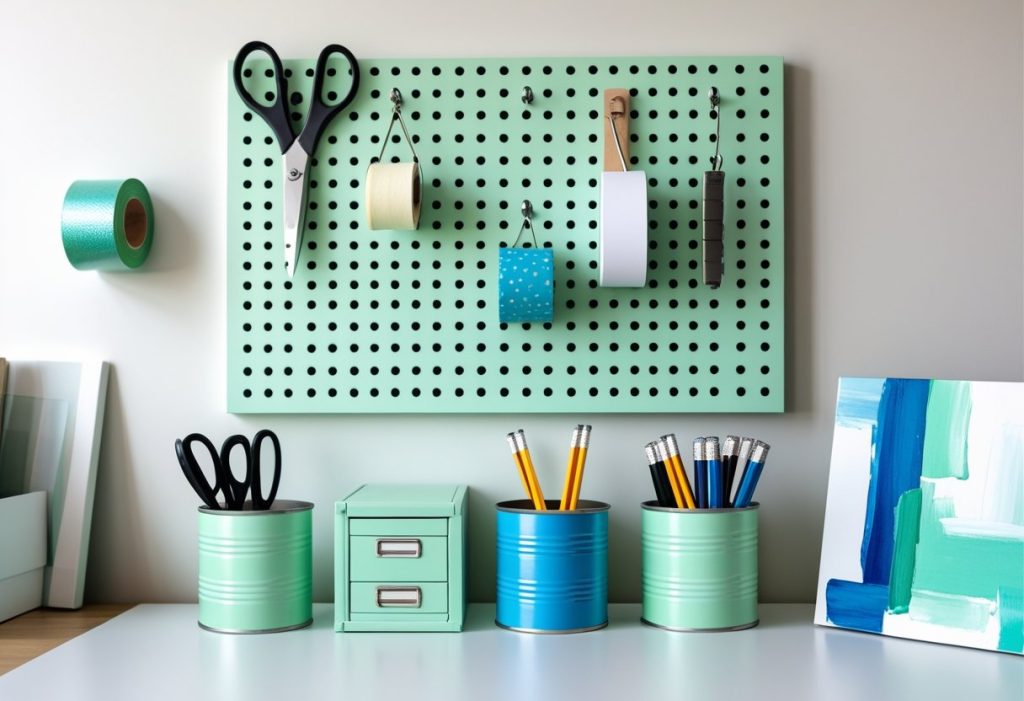
8. Technology & Office Decor (600 words)
In the 21st-century workspace, technology and office decor are not separate entities; they are deeply intertwined. The goal is no longer to just have technology, but to integrate it seamlessly so it enhances the space aesthetically and functionally, rather than detracting from it. The modern approach to office decor demands a symbiotic relationship with tech.
The Wireless Revolution
The single biggest advancement for a clean office decor aesthetic is the move toward wireless technology. Every cord eliminated is a victory for a minimalist and clutter-free desk.
- Peripherals: A wireless keyboard and mouse are essential starting points. They free up your desk surface and allow for flexible positioning.
- Charging: A wireless charging pad built into the desk or sitting on its surface eliminates the need for specific charging cables for phones and earbuds.
- Connectivity: Bluetooth speakers provide high-quality sound without the mess of audio cables, contributing to a cleaner office decor scheme.
Discreet Device Integration
Sleek, well-designed technology products are now made with aesthetics in mind. They are designed to look good on your desk, not just perform a function.
- Monitors: Ultra-thin bezels on monitors offer a more modern and less obtrusive look. Monitor arms not only improve ergonomics but also free up desk space underneath, contributing to a cleaner office decor layout.
- Webcams and Mics: Investing in a high-quality webcam and microphone that complement your setup is crucial for the hybrid work era. They should look professional on camera during calls.
Smart Lighting for Ambiance and Function
Smart lighting is a game-changer for office decor, allowing you to control the mood and functionality of your space with a tap or voice command.
- Adjustable Color Temperature: Smart bulbs can shift from cool, energizing blue light in the morning to warm, relaxing light in the evening, reducing eye strain and supporting your circadian rhythm.
- Scene Control: Program “scenes” for different activities: a bright, focused light for working, a dimmed warm light for video calls, and a very dim light for evening.
- LED Strips: Use smart LED strips behind your desk or on shelves to provide indirect ambient glow, adding a modern and customizable accent to your office decor.
Hidden Tech and Cable Management
When wires are necessary, managing them is a critical component of good office decor. The goal is to make them disappear.
- Built-in Solutions: Many modern desks come with built-in cable management trays and grommets for cords to pass through cleanly.
- Aftermarket Solutions: Cable raceways, sleeves, and clips can be used to bundle wires together and route them neatly along desk legs and walls, keeping them out of sight.
Tech as a Design Element
Sometimes, technology can be the centerpiece of your office decor. A beautiful, vintage-inspired radio, a high-end mechanical keyboard with custom keycaps, or a framed smart display can serve as both a functional tool and a decorative statement piece.
The key to harmonizing technology and office decor is intentionality. Choose tech that supports your workflow and enhances your space’s aesthetic. By thoughtfully integrating these elements, you create a workspace that is both cutting-edge and beautifully designed.
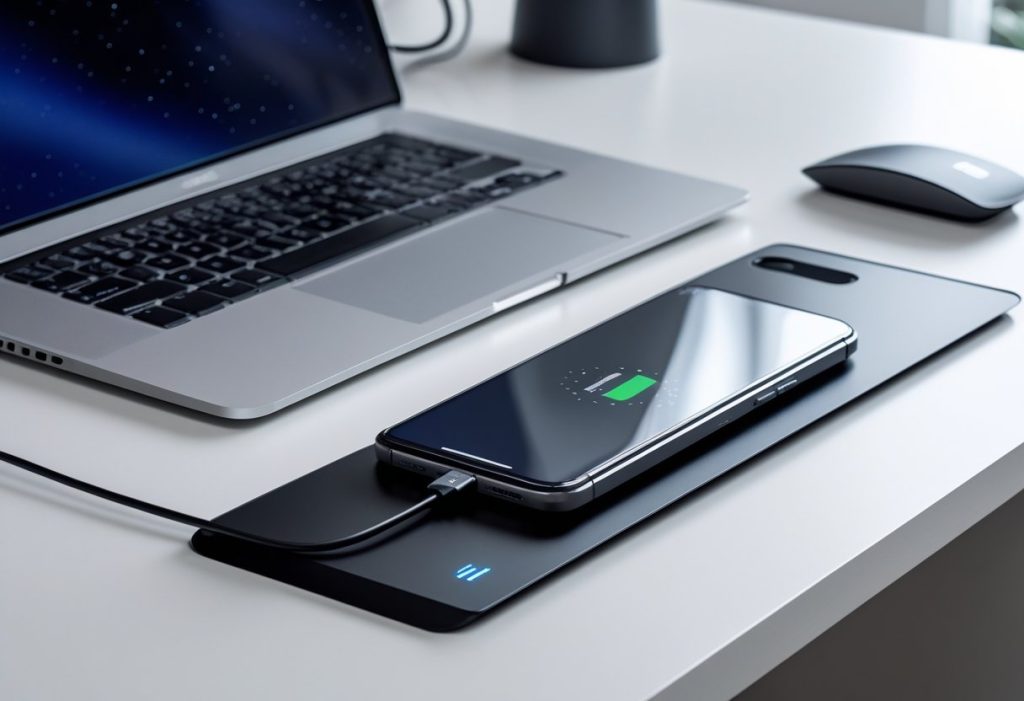
9. Office Decor Mistakes to Avoid (600 words)
Even with the best intentions, it’s easy to make missteps that can undermine your office decor goals. Being aware of these common pitfalls will help you create a space that is both beautiful and brilliantly functional. Avoid these mistakes to ensure your office supports your success.
1. Prioritizing Form Over Function
A beautiful chair that hurts your back after an hour is a bad investment. The most common office decor mistake is sacrificing ergonomics and practicality for style. Your primary furniture pieces—desk and chair—must be functional first.
Always test ergonomics before aesthetics. A stylish accessory can be added later, but chronic pain from poor furniture cannot be easily undone.
2. Poor Lighting
Relying solely on a single harsh overhead light is a major error. It causes eye strain, headaches, and fatigue, killing productivity. This is a critical office decor element that is often overlooked.
Invest in a good task lamp and use warm-toned bulbs. Layer your lighting to create a comfortable and adaptable environment throughout the day.
3. Ignoring Cable Management
A beautifully designed desk can be ruined by a tangled rat’s nest of wires snaking across the floor. Exposed cables look messy, are a tripping hazard, and disrupt the visual flow of your office decor.
Take an afternoon to manage your cables with simple solutions like clips, sleeves, or raceways. This small effort pays huge dividends in cleanliness and safety.
4. Over-Cluttering or Over-Simplifying
Finding the balance between clutter and sterility is key. A desk buried in papers and trinkets is distracting and stressful. Conversely, a completely bare, white room can feel cold, uninspiring, and impersonal.
Aim for “curated simplicity.” Have what you need and love within reach, but ensure everything has a designated home. Use storage to hide necessary clutter.
5. Choosing the Wrong Color Palette
Color has a powerful psychological impact. Choosing a color you personally dislike or one that doesn’t suit the work you do is a fundamental office decor mistake. Overly bright and stimulating colors can be as counterproductive as overly dull ones.
Consider the psychological effects of color. Test paint samples and start with accessories if you’re unsure about committing to a bold wall color.
6. Neglecting Personalization
An office that looks like a sterile hotel room lacks soul and doesn’t inspire its occupant. Failing to add any personal touches is a missed opportunity to create an emotional connection to your workspace.
Incorporate a few items that spark joy: family photos, a souvenir from a favorite trip, or artwork from a local artist. This makes the space truly yours.
7. Forgetting Plants and Life
A space without any natural elements can feel dead and draining. Neglecting to include plants is one of the easiest office decor mistakes to fix and has some of the greatest benefits for well-being.
Even if you lack a green thumb, start with a low-maintenance plant like a snake plant or pothos. The boost in air quality and mood is immediate.
8. Impulse Buying Without a Plan
Buying random items that don’t work together leads to a disjointed and chaotic look. This approach to office decor often results in wasted money and a space that never feels “finished.”
Start with a plan, a mood board, or a color scheme. Shop with intention for pieces that fit your vision and your space’s measurements.
By steering clear of these common office decor errors, you lay the groundwork for a workspace that is intentionally designed to help you thrive, both professionally and personally.
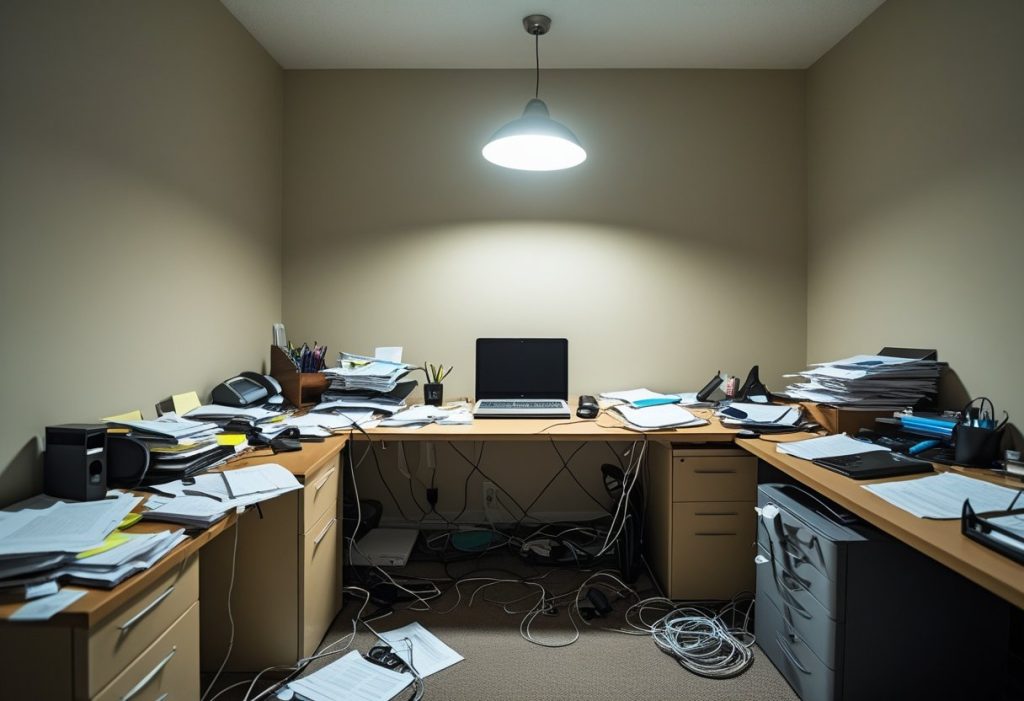
10. Best Office Decor Accessories & Products (800 words)
The right accessories are the finishing touches that elevate your space from functional to fantastic. They are the elements that inject personality, enhance organization, and maximize comfort. Here is a curated list of the best office decor accessories and products to consider for your workspace.
Ergonomic Support Accessories
Health is wealth, and these accessories provide crucial support throughout your workday.
- Ergonomic Footrest: Improves posture and reduces lower back strain by promoting proper leg positioning.
- Laptop Stand: Raises your screen to eye level, which is essential for preventing neck strain. Pair it with an external keyboard and mouse.
- Wrist Rests: Provide support for your wrists during typing and mousing, helping to prevent repetitive strain injuries.
Lighting Solutions
Proper lighting is non-negotiable for a professional office decor setup.
- Adjustable Task Lamp: A must-have for directing light exactly where you need it. Look for models with adjustable brightness and color temperature.
- Monitor Light Bar: A game-changing accessory that mounts directly to the top of your monitor, providing perfect, glare-free light for your desk without taking up any space.
Organizational Tools
A place for everything makes for a calm mind. These tools are both functional and stylish.
- Desk Organizer Set: A cohesive set of trays, pen holders, and document sorters made from materials like wood, metal, or acrylic keeps your desktop tidy.
- Cable Management Box: A simple box that hides your power strip and all its tangled cords, instantly cleaning up your space.
- Vertical File Organizer: Keeps important papers upright and within reach without creating piles.
Comfort & Textiles
Textiles add warmth, texture, and acoustic comfort to your office decor.
- Quality Desk Chair Cushion: Adds an extra layer of comfort and lumbar support, especially if your chair isn’t perfect.
- Area Rug: Defines your workspace, adds color and pattern, and reduces noise. Choose a low-pile rug for easy chair movement.
- Throw Blanket: Drape a soft, stylish throw over your guest chair for comfort during long meetings or for a cozy break.
Personalization & Inspiration
These items make the space uniquely yours and keep you motivated.
- Customizable Desk Pad: A large desk pad (or mat) protects your desk surface and can be customized with designs, calendars, or to-do lists.
- Inspirational Wall Art: Choose prints or posters with quotes, landscapes, or abstract art that you find motivating and that matches your office decor style.
- Photo Frames: Display pictures of loved ones, pets, or memorable vacations to create a personal connection to your space.
Greenery and Life
Plants are the easiest way to boost your mood and your office decor.
- Low-Maintenance Plants: A snake plant, ZZ plant, or pothos are virtually indestructible and thrive in indoor light.
- Modern Planters: Elevate your plants with stylish pots that complement your decor—ceramic, concrete, or woven baskets.
- Desktop Terrarium or Succulent: A small, self-contained garden adds a touch of green without requiring much care.
Tech Accessories
Integrate your technology seamlessly and stylishly.
- Docking Station: Reduces cable clutter by allowing you to connect all your peripherals with a single cable to your laptop.
- Wireless Charger: A sleek charging pad keeps your phone powered up without a cable mess.
- Quality Webcam and Headset: Essential for professional video calls. Choose models with good reviews and a design that fits your aesthetic.
Aromatherapy and Ambiance
Engage another sense to create a truly immersive environment.
- Essential Oil Diffuser: A subtle, stylish way to diffuse calming scents like lavender or invigorating scents like peppermint into your office.
- High-Quality Speaker: A small Bluetooth speaker fills your space with high-quality sound for focus music or podcasts.
Investing in these key office decor accessories will dramatically improve your daily experience, making your workspace more organized, comfortable, inspiring, and uniquely you.
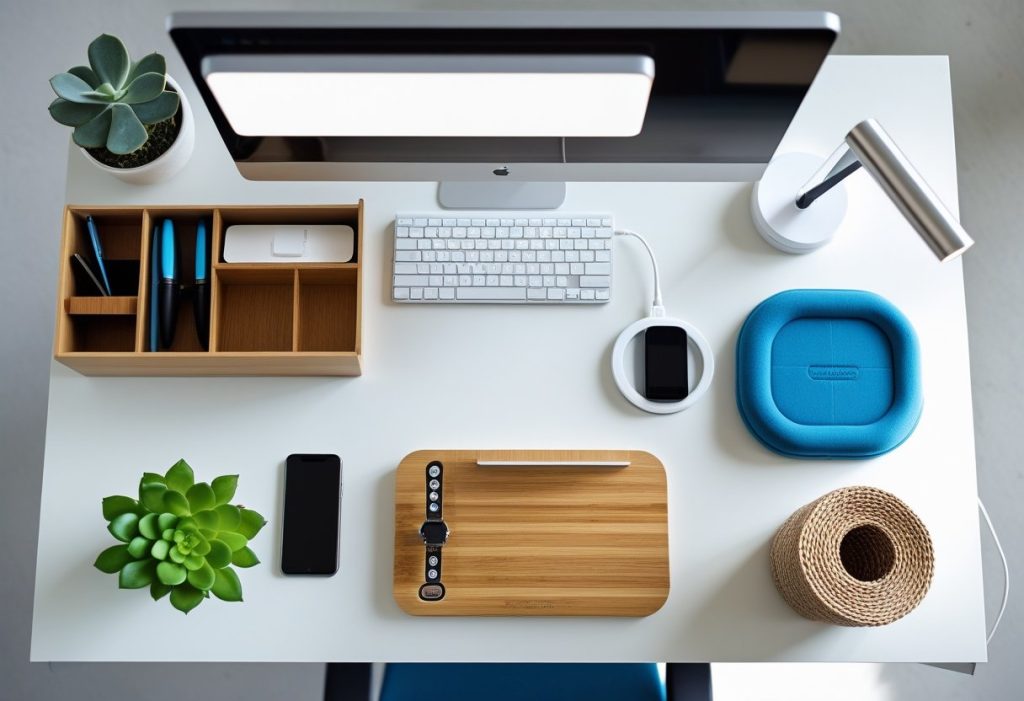
11. Conclusion: Creating a Productive & Beautiful Workspace
Your journey through this ultimate guide has equipped you with the knowledge to transform your workspace. We’ve explored the profound psychology behind office decor, the essential elements that form its foundation, and the myriad styles and ideas that can bring it to life.
Remember, curating your office decor is not a one-day project. It’s an ongoing process of refining your environment to better support your evolving work and well-being. Start with the fundamentals: invest in ergonomics, maximize your light, and conquer clutter. These steps alone will yield significant improvements in your daily comfort and output.
From there, let your personality and professional needs guide you. Whether you draw inspiration from the calm of Scandinavian design, the energy of industrial elements, or the professionalism of a traditional style, ensure your choices are intentional. Each item you bring into your space should serve a purpose—whether functional, inspirational, or aesthetic.
Don’t underestimate the power of the small details. A comfortable throw blanket, a cherished photo, the gentle glow of a task lamp, or the vibrant green of a plant—these are the touches that transform a sterile office into a nurturing haven for productivity and creativity. Your office decor is a reflection of your commitment to your craft and to yourself.
At CozyNestDecor.pro, we believe that your environment is a key ingredient in your recipe for success. A well-designed workspace is your partner in achieving your goals. It’s where ideas are born, projects are completed, and careers are built.
We encourage you to use this guide as a roadmap. Return to it as you plan your layout, choose your color palette, and select your accessories. Avoid the common pitfalls, embrace the trends that resonate with you, and don’t be afraid to roll up your sleeves with a DIY project.
Your perfect office awaits. It’s a space that doesn’t just look good in pictures—it feels good to work in. It’s a space that minimizes distractions and maximizes potential. It’s a space that you are proud of and excited to enter each morning.
Begin your transformation today. Identify one change you can make right now. Maybe it’s decluttering your desk, ordering a plant, or finally tackling that cable management. Small steps lead to big transformations.
Thank you for allowing us to guide you. Now, go forth and create a workspace that is not only modern, inspiring, and productive but also uniquely and perfectly yours.
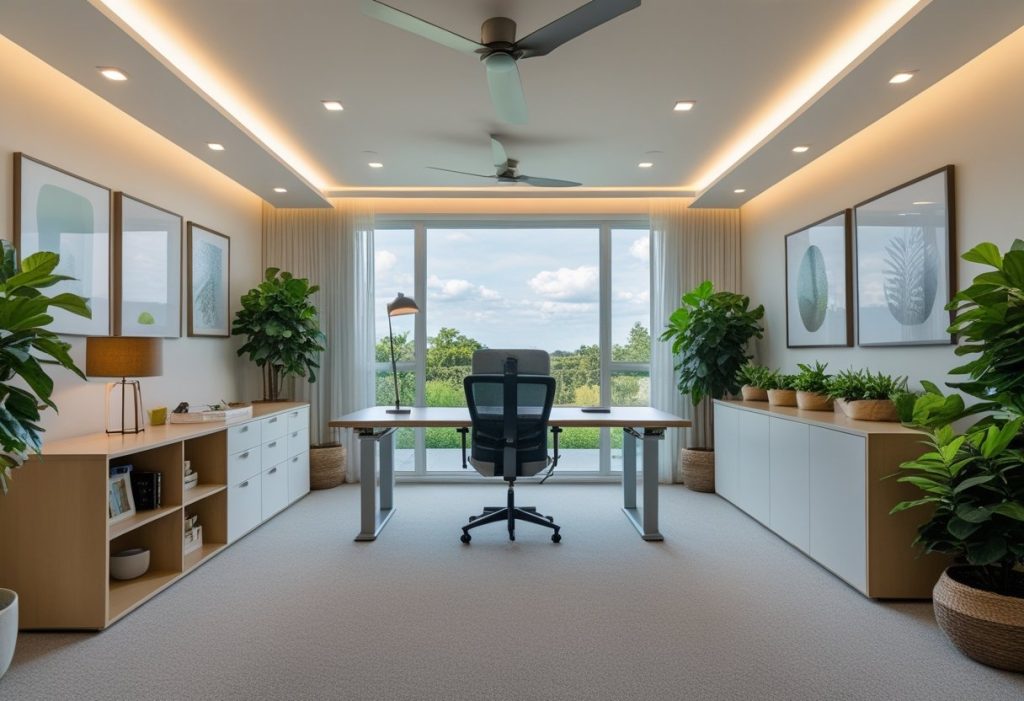
The All Pics Are Available In The Below.
